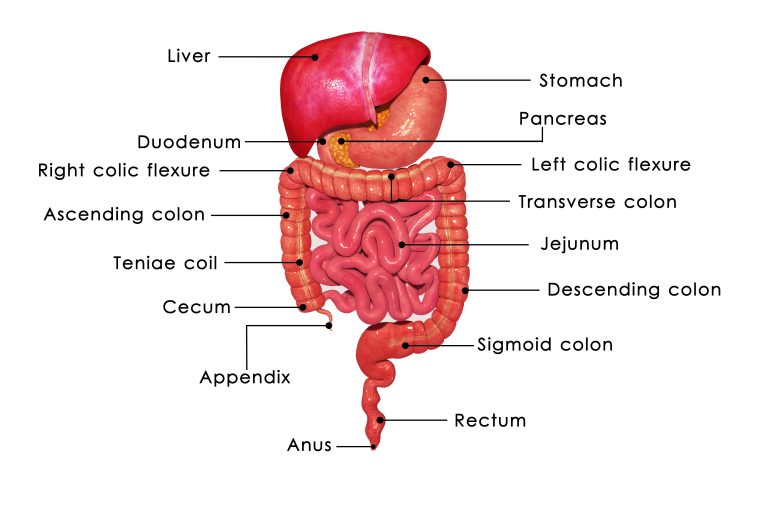Neuroendocrine Tumors of the Gastrointestinal Tract
Home » For Patients old » NET Tests & Treatments » NET Sites » GI
It can be hard to recognize neuroendocrine tumor symptoms. They can be easily mistaken for other common conditions. Furthermore, depending on its location, a neuroendocrine tumor may cause different symptoms. One of the most common locations for neuroendocrine tumors (NETs) is the gastrointestinal (GI) tract. The top incidence rates for GI sites are:
Neuroendocrine tumors (NETs) occur in the gastrointestinal (GI) tract, most commonly in the:
- Small intestine (duodenum, jejunum, and ileum)
- Stomach
- Colon
- Rectum

What is the gastrointestinal tract?
The gastrointestinal (GI) tract is made up of organs that help digest food. 4
Stomach: The stomach stores swallowed food and liquid, mixes the food and liquid with digestive juice, and slowly empties into the small intestine.
Small intestine: The muscles of the small intestine mix food with digestive juices from the pancreas, liver, and intestine, while absorbing vitamins and nutrients from food. It is made up of three sections: duodenum, jejunum, and ileum.
Colon: The colon is part of your large intestine, which also helps to break down what you eat while absorbing liquid from the material.
Rectum: The rectum stores stool until it pushes it out during a bowel movement
GI neuroendocrine tumor symptoms
Some gastrointestinal (GI) neuroendocrine tumors (NETs) do not cause any signs or symptoms19. A GI NET may cause symptoms when it:
- Overproduces and releases hormones into the bloodstream
- Grows large enough to cause blockages in the GI tract
Small intestine neuroendocrine tumor symptoms
Duodenum
Neuroendocrine tumor signs and symptoms in the duodenum (first part of the small intestine, which connects to the stomach) may include:19
- Abdominal pain
- Constipation
- Diarrhea
- Change in stool color (for example, white or clay colored)
- Nausea
- Vomiting
- Jaundice from blockage of bile duct (yellowing of the skin and whites of the eyes)
- Heartburn
Jejunum and ileum
Neuroendocrine tumor signs and symptoms in the jejunum (middle part of the small intestine) and ileum (last part of the small intestine, which connects to the colon) may include:19
- Abdominal pain
- Weight loss
- Feeling very tired
- Feeling bloated
- Diarrhea
- Nausea
- Vomiting
Colon neuroendocrine tumor symptoms
Neuroendocrine tumor signs and symptoms in the colon may include:19
- Abdominal pain
- Weight loss
Rectum neuroendocrine tumor symptoms
Neuroendocrine tumor signs and symptoms in the rectum may include:19
- Blood in the stool
- Pain in the rectum
- Constipation
Functional v. non-functional tumors
Non-functional neuroendocrine tumors
Non-functional neuroendocrine tumors do not overproduce and secrete hormones into the bloodstream. This sometimes leads to a tumor growing for a long time without causing signs or symptoms. A large tumor, however, can causes sign or symptoms if it blocks parts of the GI tract.6
Functional neuroendocrine tumors
When a GI NET over produces and releases hormones into the bloodstream, the tumor is called a “functional” tumor. The hormones released by GI NETs are usually metabolized by the liver as blood flows from the gut to that organ. If the tumor has spread to the liver and the liver enzymes cannot destroy the extra hormones made by the tumor, high amounts of these hormones may remain in the body and cause carcinoid syndrome. 18,19
Carcinoid syndrome
Signs and symptoms of carcinoid syndrome include:19

- Flushing: redness or warm feeling in the face and neck
- Abdominal pain
- Feeling bloated
- Diarrhea
- Wheezing or other trouble breathing
- Fast heartbeat
- Lower extremity swelling (if the hormones affect the right side of the heart and its valves)
What is carcinoid syndrome?
Carcinoid syndrome can lead to heart damage or heart disease.18 Up to one-third of those with carcinoid syndrome may develop thickening in cardiac valves.21 Talk to your doctor about any carcinoid syndrome symptoms you experience. It is important to manage carcinoid syndrome to reduce risks and prevent complications. Treatments can help alleviate the symptoms of carcinoid syndrome. Lifestyle changes, such as avoiding alcohol and certain foods, may also help to manage symptoms as some foods and stress can trigger symptoms.18
What is a carcinoid crisis?
Some patients experience severe, sudden, even life-threatening symptoms, called a carcinoid crisis. A carcinoid crisis typically occurs during surgery, invasive procedures, or in times of severe stress, affecting a person’s blood pressure and heart rate.18 A carcinoid crisis may be prevented and treated with hormone therapy.20 Therefore, before surgery or procedures, you may need to take medication to manage hormone production in order to prevent a carcinoid crisis.18

Emily Bergsland, MD, University of California, San Francisco
Overview of GI NETs Watch Video
Rathan Subramaniam, MD, PhD, UT Southwestern
PRRT approved as a treatment for GI NETs. Watch Video
Pamela Kunz, MD, chairs multidisciplinary GI Panel Discussion
Respected specialists take questions. Watch Video
Michelle Kang-Kim, MD, Mount Sinai
Functional vs. Nonfunctional NETs Watch VideoSearch for NET specialists
Find NET doctors, treatment programs, and support groups near you
4National Institute of Diabetes and Digestive and Kidney Diseases. Your digestive system and how it works. https://www.niddk.nih.gov/health-information/digestive-diseases/digestive-system-how-it-works. Accessed October 19, 2018.
6Cancer.NET Editorial Board. Neuroendocrine Tumor of the Pancreas: Symptoms and Signs. 2017. https://www.cancer.net/cancer-types/neuroendocrine-tumor-pancreas/symptoms-and-signs. Accessed October 22, 2018.
18National Cancer Institute. Cancer Staging. https://www.cancer.gov/about-cancer/diagnosis-staging/staging. Accessed August 1, 2018.
19Memorial Sloan Kettering Cancer Center. What is “cure?” https://www.mskcc.org/experience/living-beyond-cancer/resources-survivors/what-cure. Accessed December 21, 2012.
20Goretzi PE, Mogl MT, Akca A, Pratschke J. Curative and palliative surgery in patients with neuroendocrine tumors of the gastro-entero-pancreatic (GEP) tract. Reviews in Endocrine and Metabolic Disorders, 018;19(2):169-178.
21Cancer.Net Editorial Board. Neuroendocrine Tumor of the Gastrointestinal Tract. 2018. https://www.cancer.net/cancer-types/neuroendocrine-tumor-gastrointestinal-tract/types-treatment/ Accessed October 28, 2018.
